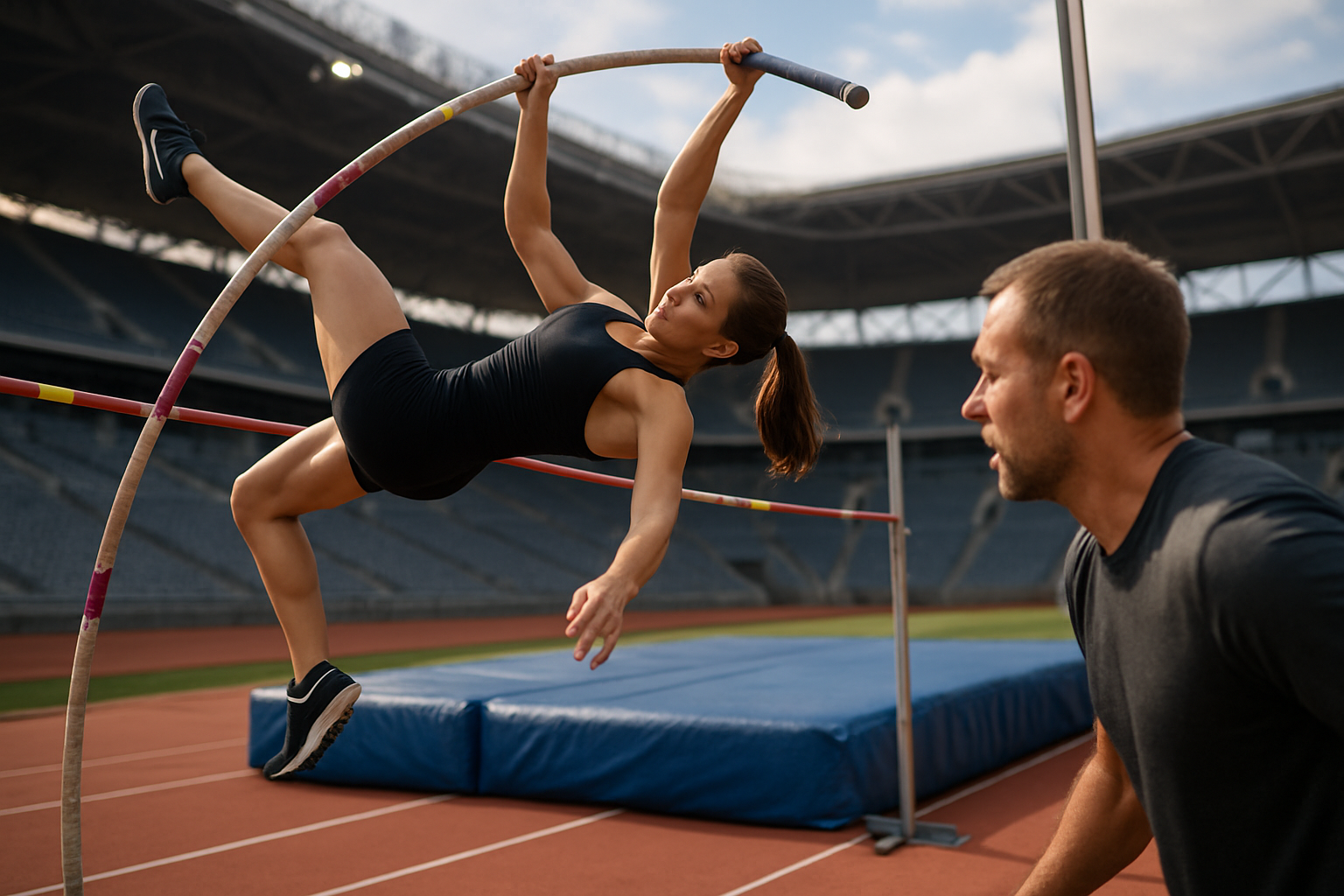The Biomechanics of Pole Vaulting: Pushing Human Limits
In the realm of athletics, few events capture the imagination quite like pole vaulting. This unique blend of speed, strength, and aerial acrobatics pushes the boundaries of human physical capability, challenging athletes to defy gravity in a breath-taking display of skill and courage. As we delve into the intricate world of pole vaulting biomechanics, we uncover the fascinating interplay of physics, physiology, and technique that allows vaulters to soar to incredible heights.

The evolution of pole vaulting equipment has played a crucial role in the sport’s development. Early vaulters used rigid poles made of hickory or ash, which limited the heights they could achieve. The introduction of bamboo poles in the 1900s allowed for greater flexibility and higher vaults. The real game-changer came in the 1950s with the advent of fiberglass poles, which revolutionized the sport by providing unprecedented energy return and allowing vaulters to reach previously unimaginable heights.
Today, pole vaulting is a staple of track and field competitions worldwide, featuring in the Olympic Games and other major athletic events. The current world records stand at an astonishing 6.22 meters for men (set by Armand Duplantis in 2023) and 5.06 meters for women (set by Yelena Isinbayeva in 2009), showcasing the incredible heights modern vaulters can achieve.
The Physics Behind the Vault
At its core, pole vaulting is a masterful manipulation of energy transformation. The vaulter’s goal is to convert their horizontal kinetic energy from the run-up into vertical potential energy, propelling them over the bar. This process involves several key physical principles:
-
Conservation of Energy: The total energy in the system remains constant throughout the vault. The vaulter’s initial kinetic energy is converted into elastic potential energy as the pole bends, then into gravitational potential energy as they rise, and finally back into kinetic energy as they clear the bar and fall to the mat.
-
Elastic Potential Energy: The flexibility of modern fiberglass poles is crucial. As the vaulter plants the pole and takes off, their momentum causes the pole to bend, storing elastic potential energy. This energy is then released as the pole straightens, propelling the vaulter upwards.
-
Rotational Mechanics: As the vaulter rises, they must rotate their body to clear the bar. This rotation is initiated during the take-off and continues throughout the vault, requiring precise timing and body control.
-
Center of Mass: The vaulter must manipulate their center of mass throughout the vault. During the take-off and pole bend, they lower their center of mass to maximize the bending of the pole. As they rise and rotate, they shift their center of mass to clear the bar efficiently.
Understanding these physical principles is essential for coaches and athletes to optimize performance and push the limits of what’s possible in pole vaulting.
The Biomechanical Sequence of a Pole Vault
A successful pole vault is a complex sequence of movements, each critical to achieving maximum height. Let’s break down the biomechanics of each phase:
-
The Approach: The vaulter begins with a controlled sprint, typically covering 30-40 meters. This phase is crucial for building up the kinetic energy needed for the vault. The athlete must maintain an optimal speed that allows for a powerful take-off without compromising control.
-
The Plant and Take-off: As the vaulter reaches the end of their approach, they lower the pole into the box. The timing of this plant is critical - too early or too late can disrupt the entire vault. At take-off, the vaulter transfers their horizontal momentum into the pole, initiating its bend. The take-off leg generates significant force, while the free leg swings upward to assist in the pole’s compression.
-
The Swing and Extension: As the pole bends, the vaulter swings their legs upward and backward, creating a “C” shape with their body. This motion helps to further bend the pole and positions the body for the upward drive. As the pole begins to recoil, the vaulter extends their body, pushing off the pole to maximize their upward velocity.
-
The Turn and Fly-away: As the vaulter reaches peak height, they must quickly rotate their body to clear the bar. This involves a rapid hip turn and arm pull, transitioning from a vertical position to horizontal. The timing of this turn is crucial - too early, and the vaulter won’t reach maximum height; too late, and they risk hitting the bar.
-
The Bar Clearance and Landing: In the final phase, the vaulter arches over the bar, using body positioning to minimize the risk of contact. After clearing the bar, they quickly rotate to land safely on their back in the landing pit.
Each of these phases requires precise timing, strength, and technique. The seamless integration of these movements is what allows elite vaulters to achieve remarkable heights.
Muscular Demands and Energy Systems
Pole vaulting places unique demands on the human body, requiring a combination of explosive power, core strength, and upper body endurance. The primary muscle groups involved include:
-
Lower The quadriceps, hamstrings, and calves generate the power for the approach and take-off. The gluteal muscles play a crucial role in hip extension during the swing and turn phases.
-
Core Muscles: The abdominals and lower back muscles are essential for maintaining body control throughout the vault, particularly during the swing and turn phases.
-
Upper The shoulders, arms, and chest muscles work to control the pole during the plant and provide the pulling force needed for the turn and fly-away.
From an energy system perspective, pole vaulting primarily relies on the ATP-PC (adenosine triphosphate-phosphocreatine) system. This anaerobic system provides the explosive energy needed for the short duration of the vault. However, the repeated efforts required in training and competition also necessitate a well-developed aerobic system for recovery between vaults.
Training Methodologies for Pole Vaulters
Developing a successful pole vaulter requires a multifaceted training approach that addresses the various physical and technical demands of the event. Key components of a comprehensive pole vault training program include:
-
Sprint Training: Improving sprint speed and acceleration is crucial for generating the kinetic energy needed for a powerful vault. This involves both short sprints (20-30 meters) for explosive start power and longer sprints (40-60 meters) for speed endurance.
-
Strength Training: A well-designed strength program is essential for pole vaulters. This typically includes compound lifts like squats and deadlifts for lower body power, as well as pull-ups and bench presses for upper body strength. Olympic lifts such as cleans and snatches are often incorporated to develop explosive power.
-
Plyometric Training: Box jumps, depth jumps, and bounding exercises help develop the explosive leg power needed for an effective take-off.
-
Gymnastics and Acrobatics: Many pole vaulters incorporate gymnastics training to improve body awareness, flexibility, and rotational skills. Exercises on the rings and high bar are particularly beneficial.
-
Technical Drills: Specific pole vault drills focus on individual components of the vault, such as pole carries, plants, and swing-ups. These drills allow vaulters to refine their technique without the complexity of a full vault.
-
Mental Training: The psychological aspect of pole vaulting cannot be overlooked. Visualization techniques, mindfulness practices, and strategies for managing competition stress are crucial for consistent performance.
-
Video Analysis: Coaches often use slow-motion video analysis to provide detailed feedback on technique, allowing vaulters to make precise adjustments to their form.
-
Periodization: A well-structured training plan typically follows a periodization model, cycling through phases of general conditioning, specific strength development, technical refinement, and competition preparation.
The integration of these various training elements requires careful planning and individualization based on the athlete’s strengths, weaknesses, and stage of development.
Biomechanical Analysis Tools in Pole Vaulting
Advancements in technology have provided coaches and biomechanists with powerful tools for analyzing and optimizing pole vault technique. Some of the key technologies employed include:
-
High-Speed Video Cameras: These allow for frame-by-frame analysis of the vault, capturing movements too quick for the naked eye to perceive. Multiple cameras can provide 3D reconstructions of the vault for comprehensive analysis.
-
Force Plates: Embedded in the runway and take-off area, force plates measure the ground reaction forces during the approach and take-off, providing insights into the athlete’s power generation and force application.
-
Motion Capture Systems: Using markers placed on key points of the athlete’s body, these systems create detailed 3D models of the vaulter’s movements, allowing for precise analysis of joint angles, velocities, and accelerations throughout the vault.
-
Electromyography (EMG): This technique measures muscle activation patterns during the vault, helping to identify which muscles are engaged at different phases and potentially highlighting areas for improved muscle recruitment.
-
Pole Bend Analysis: Specialized sensors can measure the degree of pole bend and the rate of recoil, providing data on energy storage and release during the vault.
-
Wind Tunnels: Some advanced training facilities use wind tunnels to study the aerodynamics of the vaulter’s body position during the fly-away and bar clearance phases.
-
Virtual Reality (VR) Training: Emerging VR technologies allow vaulters to practice their technique in a safe, controlled environment, potentially accelerating skill acquisition and reducing injury risk.
These tools provide a wealth of data that, when properly interpreted, can guide technique refinements and inform training strategies. However, it’s important to note that the art of coaching still plays a crucial role in translating this data into practical improvements for the athlete.
Injury Prevention and Management in Pole Vaulting
While pole vaulting is an exhilarating sport, it also carries inherent risks due to the heights and forces involved. Common injuries in pole vaulting include:
-
Acute Injuries: These can result from falls or improper landings and may include sprains, fractures, or concussions.
-
Overuse Injuries: The repetitive nature of training can lead to conditions such as shoulder impingement, lower back pain, or stress fractures in the feet or lower legs.
-
Pole-Related Injuries: Improper grip or pole breakage can result in hand or wrist injuries.
To mitigate these risks, a comprehensive injury prevention strategy is essential:
-
Proper Technique: Emphasizing correct form in all aspects of the vault, from the approach to the landing, is crucial for injury prevention.
-
Strength and Conditioning: A well-rounded fitness program helps prepare the body for the demands of vaulting and reduces injury risk.
-
Equipment Safety: Regular inspection of poles, mats, and other equipment is vital. Proper sizing of poles based on the vaulter’s weight and skill level is also crucial.
-
Progressive Training: Gradually increasing the difficulty of vaults and the intensity of training helps prevent overuse injuries and allows for proper skill development.
-
Recovery and Rest: Adequate rest between training sessions and competitions is essential for tissue repair and injury prevention.
-
Psychological Preparation: Mental training can help vaulters manage fear and anxiety, reducing the risk of hesitation-related accidents.
-
Environmental Considerations: Proper assessment of wind conditions and ensuring adequate lighting in indoor facilities are important safety measures.
When injuries do occur, a multidisciplinary approach involving coaches, sports medicine professionals, and physiotherapists is crucial for effective management and safe return to sport.
The Future of Pole Vaulting: Pushing the Boundaries
As our understanding of the biomechanics of pole vaulting continues to evolve, so too does the potential for athletic achievement in this demanding event. Several trends and areas of research point to exciting developments on the horizon:
-
Material Science: Ongoing research into pole materials and design could lead to poles that provide even greater energy return, potentially allowing for higher vaults.
-
Genetic Insights: Advances in sports genetics may help identify individuals with natural predispositions for pole vaulting success, informing talent identification and development programs.
-
Neuromuscular Training: Emerging techniques in neuromuscular training could enhance the speed and precision of the complex motor patterns involved in vaulting.
-
Artificial Intelligence in Coaching: AI-powered analysis of biomechanical data could provide real-time feedback and personalized technique recommendations.
-
Virtual Reality Training: More sophisticated VR systems may allow vaulters to practice high-risk techniques safely and accelerate skill acquisition.
-
Nutritional Strategies: Tailored nutritional approaches could optimize body composition and energy availability for peak performance.
-
Altitude Training: Investigating the effects of altitude training on pole vault performance could lead to new preparation strategies for major competitions.
-
Psychological Resilience: Advanced mental training techniques may help vaulters push their limits while maintaining composure under pressure.
As these areas develop, we may see pole vaulters reaching heights that seem impossible by today’s standards. However, it’s important to note that as performances improve, so too must our focus on athlete safety and the integrity of the sport.
The Artistry and Science of Flight
Pole vaulting stands as a testament to the remarkable capabilities of the human body and mind. It is a sport that demands a unique combination of speed, strength, flexibility, and courage, all channeled through a carbon fiber pole to propel the human form to extraordinary heights. The biomechanics of pole vaulting reveal the intricate dance between physics and physiology that makes these feats possible.
As we’ve explored, successful pole vaulting requires a deep understanding of the physical principles at play, meticulous technique refined through years of practice, and a harmonious integration of various training methodologies. The use of advanced biomechanical analysis tools has opened new avenues for performance optimization, allowing coaches and athletes to fine-tune every aspect of the vault.
Yet, for all its scientific underpinnings, pole vaulting retains an element of artistry. The fluidity of a perfectly executed vault, the moment of suspension at peak height, and the graceful arc over the bar speak to the aesthetic beauty of the sport. It is this combination of scientific precision and athletic artistry that continues to captivate audiences and inspire athletes to push the boundaries of human potential.
As we look to the future, the evolving understanding of pole vault biomechanics promises to unlock new levels of performance. However, the essence of the sport will always lie in the courage and skill of the individual athlete, facing the challenge of gravity with nothing but a flexible pole and their own determination.
In the end, pole vaulting remains a powerful metaphor for human achievement – a vivid demonstration of our ability to overcome seemingly insurmountable obstacles through a combination of physical prowess, technical skill, and indomitable spirit. As we continue to unravel the biomechanical secrets of this fascinating sport, we not only push the limits of athletic performance but also deepen our appreciation for the remarkable capabilities of the human body and mind.





